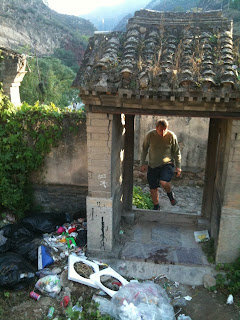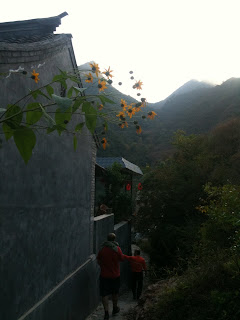Excuse me if I am yawning, but last night I slept in a Chinese court yard outside Beijing. We got back home very early this morning, just in time for Paul to get a coffee, take a shower, and go to work. (Today was his first day at work after the short October break, but the boys are home from school till Monday.)
We spent our court yard night in a little town to the West of Beijing called Cuandixia. There's no way I can pronounce that name. I think I know how to say it -- Tsjoewan-die-shiaah in Dutch or Tchouwan-di-shiaah in English -- but somehow no-one ever understands me when I say it. Luckily, our driver -- again the famous Mr. Li -- knew exactly where it was, and despite some Beijing traffic we zipped up there in about two and a half hours.
Cuandixia is a nice, quaint old village built against a mountain slope. It's older than Beijing and sort of got stuck in time. I actually was joking with the boys that Mr. Li's car was like the Magic School Bus, the time-travelling bus that's featured in a popular science book series for kids. I must have been quite believable, because I ended up having to assure the boys we weren't really going to travel through time :-)
Well, Cuandixia clearly has one foot in the 21st century - our courtyard hotel had a TV, the toilet could be flushed (with a garden hose that hung off the side), and you had to buy a ticket for 30 kuai to even enter the town. But, apart from that, you really could imagine you were in old, if not ancient, China. All you can and are supposed to do in the town is just to wonder around the narrow streets, climb up and down the steps, admire tiny tucked-away temples, keep your kids from crashing down the narrow ridges, peek into court yards, and wonder what you will have for dinner because lunch was already so lovely.
(Weirdly enough, and I don't know if this is a Cuandixia thing, but we weren't able to get the regular white rice you get with any Chinese meal. The two restaurants we visited only had a purple-ish kind of rice, colored by a few beans mixed in with the rice. They also baked a lot of corn pancakes, which tasted like corn bread. An interesting combination of rice, bean and corn I thought, not something I expected in China.)
Speaking of food, be sure to check out the photo of Thomas on the right, carefully greeting our lunch. I should point out that up until now, our many Chinese lunches really have not included the spread of insects, dogs, or other non-traditional food choices that might come to mind when you think of China. But it is true that dishes here more often than in other places include a head or feet of an animal to show you the food is nice and fresh.
In the next picture, you can see a 92 year-old lady sitting on the steps in front of a door. Our driver pointed out her feet were rather small, suggesting that she would as a child have had her feet bound. If you are interested, this NPR article on footbinding gives a good overview of the history of the practice. I was actually surprised to learn that despite it being illegal since 1912, women continued to do it for a little while longer because of the special status -- a way up the social ladder -- small feet could bring.
In searching for more information about Cuandixia, I also came across this interesting 1996 article in the New York Times, a lovely bit of old China, languishing in the new. Today, fourteen years after this article was published, it looks like the article's predictions have come through. More people have moved away from Cuandixia, but at the same time tourism seems to be saving the village (or at least the buildings in the village, not necessarily the old way of life).
A final interesting tidbit about the town is that all the people in it are descendants of the same Han family who founded the village. I took home the business card of one of the Han's, so one day we can go back and hike a bit more in the mountains around the town. For now, this was our court yard visit. The boys did seem to enjoy their trip through time and the cozy night in our one-bedroom house.
Here are some more pictures of our adventure:
The narrow streets of Cuandixia.
Entrance to a court yard. All the home owners in the village participate in the tourist activities and have a sign to show they are a restaurant or hotel.
Lunch with driver Li.
Corn growing above the street.
The Chinese character for "Cuan" which according to Internet lore means "stove." The entire name Cuandixia refers to it being some sort of "shelter" to protect from cold and war.
Drawing at the entrance of our court yard hotel.
Part of a temple on the hill above town.
Outlook over the village. Ignore the sun and try to see the cluster of homes among the trees.
Field with corn.
Statue in a temple.
Beautiful view and some unsightly garbage. There was actually little littering in Cuandixia - the town is kept nice and clean.
Our court yard hotel. We slept in the house (a one-room house) on one side of the court yard, with friends, our driver, and some strangers in the other homes.
Just like in ancient China: Two guys sitting outside and having a drink.
For the villagers, our blond kids were the tourist attraction. The boys are posing for a picture.
At the edge of the village.
Convenient storage spot.
Subscribe to:
Post Comments (Atom)

























No comments:
Post a Comment